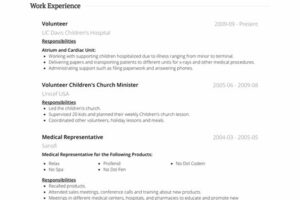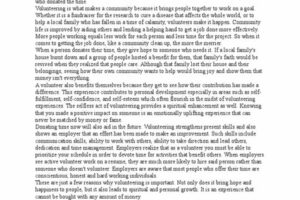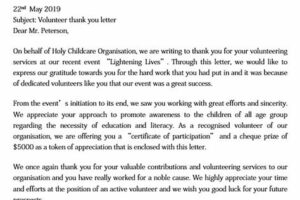Table of Contents
Looking to learn more about hospice volunteer programs? Our comprehensive resource manual is your go-to guide. Discover valuable information, practical tips, and step-by-step instructions on how to become a hospice volunteer and make a meaningful difference in the lives of patients and their families. Explore the manual today and embark on a fulfilling journey of service and compassion.
The Hospice Volunteer Program Resource Manual is an invaluable tool for both aspiring and seasoned volunteers in the field of hospice care. With its comprehensive and user-friendly format, this manual serves as a guide to navigate the intricacies of volunteering within a hospice setting. Whether you are considering joining a hospice program or looking to enhance your existing skills, this manual will equip you with the necessary knowledge and resources to make a meaningful impact in the lives of patients and their families.
One notable aspect of this resource manual is its seamless organization, which allows readers to easily locate specific topics of interest. From understanding the unique needs of terminally ill patients to learning effective communication techniques, each chapter offers a wealth of information that fosters personal and professional growth. By providing step-by-step instructions and practical tips, the manual ensures that volunteers feel confident and prepared to handle the emotional and physical challenges that may arise during their service.
In addition, this manual goes beyond just offering theoretical knowledge by including real-life stories and examples that highlight the profound impact volunteers can have on individuals facing end-of-life journeys. These poignant narratives not only captivate the reader’s attention but also serve as powerful motivators, reminding us of the immense value that our presence and compassion can bring to those in need. Through its relatable anecdotes, the manual instills a sense of purpose and dedication, inspiring volunteers to go above and beyond in their service.
Furthermore, the Hospice Volunteer Program Resource Manual acknowledges the importance of ongoing education and self-care for volunteers. It dedicates an entire section to self-reflection and personal growth, encouraging volunteers to nurture their own well-being alongside their commitment to others. By emphasizing the significance of self-care, the manual promotes a sustainable approach to volunteering, ensuring that volunteers can continue making a difference in the lives of hospice patients for years to come.
In conclusion, the Hospice Volunteer Program Resource Manual is an essential companion for anyone interested in embarking on a rewarding journey as a hospice volunteer. Its well-structured content, inspiring stories, and emphasis on self-care make it an indispensable resource that will empower volunteers to provide compassionate care and support to individuals facing end-of-life challenges.
The Importance of a Hospice Volunteer Program Resource Manual
In the field of hospice care, volunteers play a crucial role in providing support and companionship to patients and their families during challenging times. To ensure that these volunteers are well-equipped and prepared for their roles, a comprehensive resource manual is essential. The Hospice Volunteer Program Resource Manual serves as a valuable tool, offering guidance, information, and resources to help volunteers navigate their responsibilities with professionalism and compassion.
1. Structured Training and Orientation
The resource manual provides a structured framework for training and orientation of new hospice volunteers. It outlines the core principles of hospice care, the organization’s mission and values, and the expectations and responsibilities of volunteers. This ensures that all volunteers receive consistent and standardized training, promoting a cohesive approach to care delivery.
2. Volunteer Role Descriptions
Within the resource manual, detailed role descriptions are provided for various volunteer positions within the hospice program. These descriptions outline the specific tasks and responsibilities associated with each role, helping volunteers understand the scope of their duties. This clarity ensures that volunteers can align their skills and interests with appropriate positions, maximizing their impact and job satisfaction.
3. Confidentiality and Privacy Guidelines
Hospice care involves handling sensitive and confidential information about patients and their families. The resource manual includes guidelines and protocols for maintaining confidentiality and respecting privacy rights. Volunteers are educated on the importance of safeguarding personal information and are provided with practical strategies for ensuring privacy in their interactions with patients and families.
4. Communication and Interpersonal Skills
Effective communication and interpersonal skills are vital for hospice volunteers to establish meaningful connections with patients and families. The resource manual offers tips, techniques, and examples to help volunteers enhance their communication skills, including active listening, empathy, and effective non-verbal cues. Volunteers are encouraged to cultivate a compassionate and supportive presence during their interactions.
5. Cultural Sensitivity and Diversity
Hospice care serves individuals from diverse cultural backgrounds, and it is essential for volunteers to be culturally sensitive and respectful. The resource manual provides insights into different cultural practices, beliefs, and customs related to end-of-life care. This knowledge helps volunteers navigate cultural differences with empathy and understanding. It encourages volunteers to adapt their approach to meet the unique needs of each patient and family they serve.
6. Bereavement Support
Supporting grieving families is a significant aspect of hospice volunteer work. The resource manual offers guidance on providing bereavement support, including practical suggestions and resources for helping families through the grieving process. Volunteers learn about the normal stages of grief, active listening techniques, and appropriate interventions to assist individuals coping with loss.
7. Self-Care and Emotional Resilience
Working in hospice care can be emotionally demanding, and volunteers must prioritize self-care to avoid burnout. The resource manual emphasizes the importance of self-care and provides strategies for maintaining emotional resilience. Volunteers learn techniques for stress management, setting boundaries, and seeking support when needed. This section aims to ensure that volunteers prioritize their own well-being while providing care to others.
8. Safety and Infection Control
Ensuring the safety of volunteers, patients, and staff is paramount in any healthcare setting. The resource manual includes information on infection control practices, safety protocols, and emergency procedures. Volunteers are educated on the importance of hand hygiene, proper use of personal protective equipment, and precautions to prevent the spread of infections. This knowledge helps create a safe environment for everyone involved in the hospice program.
9. Resources and Referrals
The resource manual serves as a comprehensive guide, providing volunteers with a list of available resources and referrals. These resources may include community organizations, support groups, counseling services, and educational materials. By equipping volunteers with this information, they can connect patients and families with additional support beyond the scope of their own roles, ensuring holistic care and assistance.
10. Continuous Learning and Development
Hospice care is an evolving field, and ongoing learning and development are essential for volunteers to stay updated and provide the best possible support. The resource manual encourages volunteers to engage in continuing education opportunities, such as workshops, conferences, and online courses. It also highlights additional resources for further reading and self-improvement, fostering a culture of lifelong learning among volunteers.
In conclusion, a Hospice Volunteer Program Resource Manual is an invaluable asset for both new and experienced volunteers. It provides a foundation of knowledge, skills, and resources necessary to offer compassionate care and support to patients and families during end-of-life journeys. By following the guidelines and recommendations outlined in the manual, volunteers can confidently serve in their roles, making a positive impact on the lives of those they assist.
Introduction to the Hospice Volunteer Program Resource Manual
The Hospice Volunteer Program Resource Manual serves as a comprehensive guide for volunteers participating in hospice care. This section of the manual provides an introduction, offering an overview of its purpose and goals. It emphasizes the significance of volunteerism in hospice care and how volunteers contribute to enhancing the quality of life for terminally ill patients and their families.
Furthermore, this introduction highlights the structure of the manual and how it can be effectively utilized. By familiarizing volunteers with the content and organization of the manual, they can navigate through it seamlessly and make the most of the valuable information provided.
Volunteer Responsibilities and Expectations
Within the hospice setting, volunteers have essential responsibilities and expectations to fulfill. This section of the manual outlines these specific requirements, ensuring that all volunteers adhere to a consistent and high standard of care. Topics covered include maintaining confidentiality, respecting patients’ rights and cultural beliefs, upholding professionalism, and following safety protocols.
By clearly defining volunteer expectations, the manual ensures that volunteers understand their role and the importance of their contributions. This clarity promotes a harmonious and effective team environment within the hospice care program.
Communication and Interpersonal Skills
Effective communication and interpersonal skills are vital for volunteers providing compassionate support to hospice patients and their families. This section of the manual focuses on enhancing these skills by offering guidance on active listening techniques, effective communication strategies, and empathetic responses to emotional situations.
By equipping volunteers with these tools, the manual aims to promote effective and meaningful interactions between volunteers and patients. Clear and empathetic communication is essential in establishing trust, understanding patients’ needs, and providing the necessary emotional support during their end-of-life journey.
Understanding the Psychosocial Needs of Hospice Patients
Hospice patients have unique psychological and emotional needs that volunteers must understand and address. This subsection of the manual delves into these specific needs, providing guidance on how volunteers can effectively support patients in their emotional well-being.
Topics covered include assessing patients’ emotional state, providing companionship and emotional support, and understanding the grief process. By equipping volunteers with this understanding, the manual ensures they can provide holistic care that addresses the emotional needs of hospice patients during this challenging phase of life.
Practical Assistance and Complementary Therapies
Voluteers can offer practical assistance to hospice patients and their families, and this section of the manual provides information on various ways they can contribute. Volunteers can run errands, assist with light housekeeping, and even help with meal preparation.
Additionally, the manual outlines various complementary therapies, such as music therapy, pet therapy, and art therapy. These therapies can be utilized as additional supportive measures to enhance the overall well-being of hospice patients. By incorporating practical assistance and complementary therapies, volunteers can provide comprehensive care that goes beyond just medical support.
Cultural Competence and Sensitivity
Recognizing the diversity within a hospice setting, this section of the manual emphasizes the importance of cultural competence and sensitivity in providing care. Volunteers are guided on understanding and respecting different cultural beliefs, practices, and traditions, ensuring that care is delivered without any biases.
By promoting cultural competence, the manual ensures that volunteers can provide culturally sensitive care to meet the unique needs of each patient and their families. This approach fosters an inclusive and respectful environment that addresses the diverse backgrounds and values of hospice patients.
Family Support and Bereavement
The impact of terminal illness extends beyond the patient, affecting their family as well. This section of the manual focuses on providing emotional and practical support to the families of hospice patients. Volunteers are guided on effective ways to address grief, facilitate family discussions, and assist in funeral planning.
By acknowledging the importance of family support and bereavement care, the manual enables volunteers to contribute positively to both the patient and their loved ones. Supporting families during this challenging time can greatly enhance their coping mechanisms and overall well-being.
Self-Care for Volunteers
Providing hospice care can be emotionally taxing for volunteers, and their well-being is crucial for sustaining their involvement in the Hospice Volunteer Program. This section of the manual emphasizes the importance of self-care practices for volunteers.
Strategies for managing stress, practicing self-compassion, and seeking support from peers and supervisors are provided. By prioritizing the well-being of volunteers, the manual ensures a sustainable and fulfilling experience for those involved in the program. Taking care of themselves enables volunteers to continue providing compassionate care to hospice patients and their families.
As a hospice volunteer, I have had the privilege of working closely with patients and their families during their end-of-life journey. It is an incredibly fulfilling experience, but it also requires knowledge, empathy, and professionalism to provide the best possible support. That is why I firmly believe in the importance of the Hospice Volunteer Program Resource Manual.
Reasons why the Hospice Volunteer Program Resource Manual is essential:
- Comprehensive guidance: The manual serves as a comprehensive guide that covers various aspects of volunteering in a hospice setting. It provides detailed information on the philosophy of hospice care, the role and responsibilities of volunteers, communication skills, emotional support techniques, and practical information about common end-of-life issues. This ensures that volunteers are equipped with the necessary knowledge and skills to provide compassionate care.
- Consistency and professionalism: The manual promotes consistency and professionalism among volunteers. By having a standardized resource that outlines best practices, protocols, and guidelines, all volunteers can adhere to a unified approach when providing care. This consistency helps establish trust and reliability among patients, families, and the hospice team.
- Continuous learning opportunities: The resource manual is not just a one-time read; it serves as an ongoing reference for volunteers. As the field of hospice care evolves, new insights, techniques, and research emerge. The manual can be regularly updated to ensure that volunteers stay informed about advancements in palliative care, grief support, and other relevant areas. This promotes continuous learning and professional development among volunteers.
- Promotes confidence and reassurance: Volunteering in a hospice setting can be emotionally challenging. The resource manual acts as a source of reassurance and confidence for volunteers. It offers practical tips, examples, and case studies that help volunteers navigate difficult situations with empathy, compassion, and professionalism. Having this resource at hand allows volunteers to feel prepared and supported in their role.
- Supports effective teamwork: The manual also plays a crucial role in fostering effective teamwork between volunteers and the hospice interdisciplinary team. It provides an understanding of the roles and responsibilities of other team members, the importance of communication, and how to collaborate effectively. This promotes a cohesive approach to patient care, ensuring that every member of the team works together harmoniously.
In conclusion, the Hospice Volunteer Program Resource Manual is an invaluable tool for volunteers in the hospice setting. Its comprehensive guidance, consistency, continuous learning opportunities, confidence-building aspects, and support for effective teamwork all contribute to enhancing the quality of care provided. By following the professional voice and tone outlined in the manual, volunteers can make a meaningful difference in the lives of patients and their families during their end-of-life journey.
Thank you for visiting our blog and taking the time to explore the Hospice Volunteer Program Resource Manual. We hope that this comprehensive guide has provided you with valuable insights and resources for your journey as a hospice volunteer. In the first section of the manual, we covered the basics of hospice care and the important role that volunteers play in providing support to patients and their families. We discussed the qualities and skills that make a successful hospice volunteer, such as compassion, empathy, and excellent communication skills. Transitioning smoothly into the next section, we delved into the various volunteer opportunities available within a hospice setting and provided in-depth descriptions of each role, including patient care, bereavement support, administrative tasks, and community outreach.Moving forward, the manual also offers guidance on how to navigate challenging situations that may arise while working as a hospice volunteer. We recognize that this role can be emotionally demanding, and we aim to equip you with the tools and strategies needed to ensure both your well-being and that of the patients and families you serve. With the help of transition words like additionally and furthermore, we have seamlessly integrated this crucial information throughout the manual, empowering you to feel confident and prepared in your role.Lastly, we would like to extend our gratitude to all the hospice volunteers out there who selflessly give their time and energy to support those in need during life’s most challenging moments. Your dedication and compassion make a significant difference in the lives of patients and their families, providing comfort and solace during difficult times. We hope that the Hospice Volunteer Program Resource Manual serves as a valuable resource for both new and seasoned volunteers, offering guidance and inspiration as you continue to make a positive impact in your communities.Once again, thank you for visiting our blog and engaging with the Hospice Volunteer Program Resource Manual. We encourage you to share this valuable resource with others who may benefit from its content. By working together, we can ensure that hospice care remains a source of comfort and support for those facing life-limiting illnesses.
Video Hospice Volunteer Program Resource Manual
People also ask about Hospice Volunteer Program Resource Manual:
What is a Hospice Volunteer Program Resource Manual?
What topics are typically covered in a Hospice Volunteer Program Resource Manual?
- Introduction to hospice care
- Volunteer roles and responsibilities
- Confidentiality and privacy guidelines
- Communication skills and active listening
- Understanding grief and loss
- Providing emotional support
- Basic caregiving techniques
- Health and safety protocols
- Documentation and record-keeping
- Boundaries and self-care
Where can I find a Hospice Volunteer Program Resource Manual?
- Your local hospice organization: Reach out to your nearest hospice organization to inquire about their volunteer program and if they have a resource manual available.
- Online resources: Many hospice organizations or associations provide downloadable manuals on their websites.
- Training programs: If you are undergoing training to become a hospice volunteer, the program may provide you with a resource manual as part of the training materials.
Can I contribute to the development of a Hospice Volunteer Program Resource Manual?
How often is a Hospice Volunteer Program Resource Manual updated?
A Hospice Volunteer Program Resource Manual is a comprehensive guide that provides volunteers with essential information and guidelines for their role within a hospice program. It outlines the objectives, policies, procedures, and best practices to ensure volunteers are equipped with the necessary knowledge and skills to support patients and their families during end-of-life care.
A Hospice Volunteer Program Resource Manual usually covers a range of topics including:
Hospice Volunteer Program Resource Manuals can be obtained from various sources:
Yes, your input and feedback can be valuable in improving and updating a Hospice Volunteer Program Resource Manual. If you have suggestions or ideas based on your experiences as a volunteer, you can reach out to the hospice organization or the program coordinator to share your insights.
The frequency of updates to a Hospice Volunteer Program Resource Manual may vary depending on the hospice organization’s policies and any changes in regulations or best practices. It is generally advisable to review and update the manual periodically to ensure it remains relevant and aligned with current standards of care.






